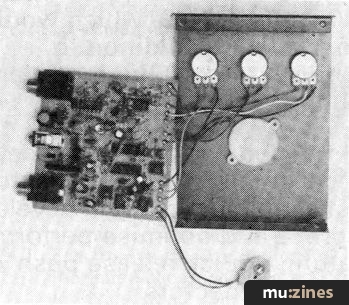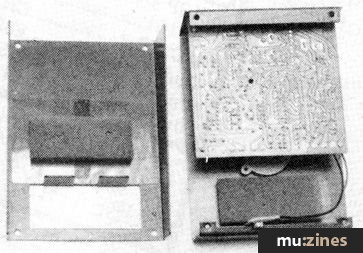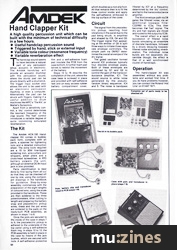Magazine Archive
Home -> Magazines -> Issues -> Articles in this issue -> View
Amdek Hand Clapper Kit | |
Article from Electronics & Music Maker, February 1984 | |
Clap Hands... here comes Roland... build this new, exciting percussion device.
A high quality percussion unit which can be built with the minimum of technical difficulty in a few hours.
• Useful handclap percussion sound
• Triggered by hand, stick or external input
• Variable tone colour (resonance frequency)
• Variable reverberation effect

The kit in its bubble pack.
The handclap sound seems to have become a natural part of any percussion setup, acoustic or electronic. The Amdek handclap will provide an acoustic drummer with this percussion sound, where the sturdy pad can be struck directly with a drumstick. The trigger input socket also allows the unit to be used with an electronic percussion machine, or even a computer. Alternatively the pad can be struck with fingers, making it a useful addition to drum machines like MPC's 'The Kit', or Mattel's Synsonics.
Apart from a sensitivity control, a 'dry' control determines the resonant frequency of the clap sound. The 'hall' control introduces a variable degree of quite convincing simulated reverberation.
The Kit
The Amdek HCK-100 Hand-clapper Kit comes in bubble-pack form, complete with all parts, a spanner for tightening nuts and a detailed instruction sheet. The extra tools required are a 15 to 30W fine-tipped soldering iron, wire-cutters and strippers, small pliers and a cross-head screwdriver. A PP3 battery powers the unit, although an external DC9v input jack is also provided.

Complete set of parts ready to be checked off.
Parts identification is best done by first laying them all out so that they can be checked off one by one, using the component drawings in the handbook for guidance. Step-by-step assembly commences with the preparation of the eight lengths of coloured wire, using the scale provided in the handbook. These are then soldered to the three potentiometers. After cutting to length and preparing the battery snap and piezoelectric pickup wires, these and the pot wires are soldered to the pads on the ready-built PCB assembly, as shown in steps 1 to 6.

Case with pots and transducer in place (steps 7-9).

Pots, battery clip and transducer fitted to PCB (steps 1-6).
Once the pots are secured to the inside of the case in steps 7 to 9, the piezoelectric pickup is adhered to the underside of the top panel using a self-adhesive foam ring. In steps 10 to 12, the PCB assembly is held in place in the case by means of the jack bushes, which are secured with nuts. A self-adhesive protective film and a self-adhesive foam pad insulate the PCB from the case bottom. A further foam pad serves to restrict the movement of the battery.

The completed Hand Clapper (steps 13-17).

Completed internal assembly (steps 10-12).
Steps 13 to 16 describe the completion of the unit, where the case base is screwed in place and provided with self-adhesive feet and an easy access rubber battery compartment cover, which doubles as a non-slip foot. All that remains then is to fit the three control knobs and apply the self-adhesive strike-pad to the top surface of the cover.

(Click image for higher resolution version)
Circuit
The signal from the piezoelectric pickup, resulting from vibrations in the panel due to the pad being struck, is amplified and shaped by IC6, Q4 and Q5. The trigger signal then appearing at the emitter of Q5 is split three ways to initiate three separate envelope controllers. The simple path via D9/R27 determines the overall envelope of the dry signal.
The gated oscillator formed around IC2 produces typically four discrete envelope peaks. Both of these envelopes are combined by Q1 and Q2 to control the gain of the transconductance amplifier, IC1. The sound source is white noise generated by the pseudorandom binary sequencer, IC4 and 5. The noise is bandpass filtered by IC7 at a frequency determined by the 'dry' control, and fed to the transconductance amplifier.
The third envelope path via D8 gates the filtered noise, via an additional lowpass filter C22/R60 to IC3a. This then becomes tha 'hall' signal. The dry and hall signals are mixed and routed to the output by IC3b.
The overall effect is a rapid succession of filtered noise bursts simulating an ensemble of discrete handclaps, followed by a slowly decaying lowpass-filtered noise simulating reverberation. The individual noise bursts are not separately discernible though; the effect is that of a well synchronised cluster of handclaps.
Operation
The hand-clapper kit was assembled without any problems and worked first time. If you do have problems however, you can contact the Roland 'Hot Line' on (Contact Details).
The unit performed very well, producing a good, attractive clap sound. The 'dry' control varies the tone of the sound from a thin clap to a deep, cupped-hand clap. The reverberation effect was found to be quite convincing, particularly with deep clap sounds. The unit was also quite sensitive, enabling it to be triggered with the fingers with the sensitivity control fully clockwise.
Despite suggestions to the contrary in the handbook, the handclapper lacked any useful degree of touch sensitive dynamics,although it was found possible to control the amplitude of the 'hall' signal dynamically to some extent.

Modifications
Although Amdek do not recommend specific modifications to the unit, the following suggestions might be worth experimenting with. First, since the output level is rather low, you may like to link out R15 to increase it. Secondly, if the clap tone is too thin, changing C24 and 26 to perhaps 0.01µF will deepen the tonal range of the dry control considerably. The third suggested modification is to increase the delay between the bursts of noise. This can be done by increasing the value of R6. Unfortunately, unless R7 is altered by the same amount, the number of bursts will be reduced. Possibly both of these resistors could be replaced by 2M2 presets so that both the length of the cluster of bursts and the burst repetition rate can be independently adjusted.
More with this topic
Practically MIDI (Part 1) |
Circuit Maker - Digital Equipment Protector |
On the Level |
Test Tone Oscillator |
How It Works - Drum Machine |
Workbench - Impedance. What is it?! |
Trigger Converter for the Yamaha SPX-90 |
Electronic Drum Sequencer - Software for BBC Micro |
An Ultra VCO From The 4720 |
The Ins and Outs of Digital Design |
Frequency Divider - Turns Gnome Into "Super-Gnome" |
 Starting Point (Part 1) |
Browse by Topic:
Electronics / Build
Publisher: Electronics & Music Maker - Music Maker Publications (UK), Future Publishing.
The current copyright owner/s of this content may differ from the originally published copyright notice.
More details on copyright ownership...
Feature
Previous article in this issue:
Help Support The Things You Love
mu:zines is the result of thousands of hours of effort, and will require many thousands more going forward to reach our goals of getting all this content online.
If you value this resource, you can support this project - it really helps!
Donations for April 2024
Issues donated this month: 0
New issues that have been donated or scanned for us this month.
Funds donated this month: £7.00
All donations and support are gratefully appreciated - thank you.
Magazines Needed - Can You Help?
Do you have any of these magazine issues?
If so, and you can donate, lend or scan them to help complete our archive, please get in touch via the Contribute page - thanks!
















